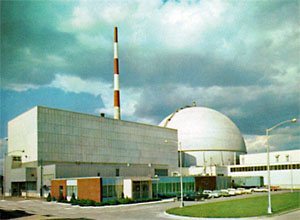
The Unit 1 reactor at the Dresden nuclear plant near Morris, Illinois was among the first nuclear power reactors built in the United States. The NRC, then called the Atomic Energy Commission, licensed it on September 28, 1959. The plant’s owner, then called the Commonwealth Edison Company or ComEd, later built two more nuclear plants at the site. ComEd permanently shut down Dresden Unit 1 on October 31, 1978. The company continues to operate Dresden Units 2 and 3.
On January 25, 1994, a worker entered the Dresden Unit 1 containment building and discovered 55,000 gallons of water in its basement. The source of the water was traced to a section of the service water system piping that had frozen and ruptured. Records showed that the Unit 1 containment building had not been heated since the 1988/1989 winter.
Further investigation revealed the potential for a water-filled portion of the fuel transfer system inside the containment to also freeze. If that piping ruptured, it would have resulted in partial draining of water from the spent fuel pool that contained 560 irradiated fuel assemblies. The upper few feet of the irradiated fuel assemblies would have been uncovered. The decay heat generated by irradiated fuel assemblies – which had been removed from the reactor core nearly two decades earlier – was not high enough to have caused the fuel to melt. However, the loss of water shielding would have created high radiation levels. For example, the radiation dose rate at the railing around the spent fuel pool would have jumped to an estimated 733 rem per hour. That radiation level would have been high enough that it could have interfered with operations at Dresden Units 2 and 3.
The spent fuel pool at Unit 1 was not equipped with any leak detection systems, so workers would not have been warned about the situation until the high radiation levels made recovery more challenging.
The NRC concluded that the Dresden staff had focused its attention on the operating units and had improperly assumed that no significant problems could occur at the defunct Unit 1.
It was not the first time that cold weather caused problems at a nuclear facility in Illinois. General Electric’s Midwest Fuel Recovery Plant outside Morris lost power for two hours in January 1977. The outside temperature was -19°F. When the power was restored, workers discovered that a pipe in the cooling system for the spent fuel pool had frozen and ruptured. The cooling system remained shut down for several weeks while the piping was repaired. Decay heat from the irradiated fuel assemblies heated the pool’s water to 115°F. The humidity inside the building rose to an uncomfortable level, but otherwise this incident had no adverse impact.
On January 3, 1979, workers at the Davis-Besse plant in Ohio performed a monthly test of the high pressure injection (HPI) pumps. During this test, they could not establish flow through the recirculation pipe running from the pump to the borated water storage tank. They investigated and determined that a portion of the line had frozen solid. The piping had been insulated and wrapped with a heated wire to prevent freezing, but it had frozen anyway.
In their evaluation of the January 3, 1979, event, the folks at Davis-Besse concluded that the pumps were still operable even though the recirculation line was frozen solid. Therefore, they took no immediate action to thaw the frozen pipe. Two days later, the piping thawed and the test was successfully completed.
Later, the Davis-Besse staff realized that they’d underestimated the risk. The frozen line degraded the HPI system. Had the HPI pumps operated for any length of time without a flow path, such as if a small pipe connected to the reactor vessel had broken, the pumps could have been disabled before they were needed to provide cooling water to the reactor core. The event was reported to the NRC on March 12, 1979 – less than three weeks before a small pipe connected to the reactor vessel at Three Mile Island Unit 2 drained away its cooling water to cause the worst accident (so far) in U.S. nuclear history. There, the HPI pumps automatically started to makeup the water inventory, but the operators turned them off based upon a faulty instrument indication of too much water.
Our Takeaway
These events, reinforced by this year’s disaster at Fukushima Dai-Ichi, illustrate the folly of underestimating nature. You may get away with it today, tomorrow, next year, and perhaps the year after that. But unless you are properly prepared for nature all the time, someday nature can transform lack of readiness into lack of safety. One bad day at Fukushima Dai-Ichi more than offset nearly four decades of good days.
80%, 90%, and even 99% is not a passing score in nuclear safety when the luck runs out.
“Fission Stories” is a weekly feature by Dave Lochbaum. For more information on nuclear power safety, see the nuclear safety section of UCS’s website and our interactive map, the Nuclear Power Information Tracker.
